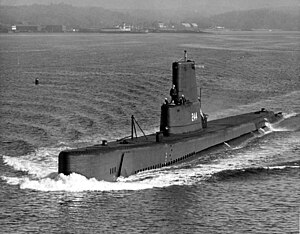USS Cavalla (SS-244)

|
|
|---|---|
| period of service |
|
| Keel laying: | March 4, 1943 |
| Launch | November 14, 1943 |
| Commissioning: | February 29, 1944 |
| Fate: | Museum ship |
| Decommissioned: | December 30, 1969 |
| Technical specifications | |
| Displacement: | 1526 t surfaced, 2424 t submerged |
| Length: | 95.33 meters |
| Width: | 8.30 meters |
| Draft: | 4.65 meters |
| Drive: | 4 diesel and 4 electric motors each |
| Power: | 4 × 990 kW (diesel) 4 × 500 kW (electric motors) |
| Speed: | 20.25 node surfaced, 8, 75 dipped node |
| Crew: | 6 officers + 54 seamen |
| Armament: | 6 × 533 mm torpedo tubes at the front 4 torpedo tubes at the rear 24 torpedoes 1 × 76.2 mm deck gun 2 × 50 machine guns 2 × 30 machine guns |
The USS Cavalla (SS / SSK / AGSS-244) was a United States Navy submarine and belonged to the Gato class .
history
The Cavalla was laid down at Electric Boat in March 1943 and was launched after eight months of construction. At the end of February 1944 the boat was put into service.
On May 9, the Cavalla reached Pearl Harbor , underwent a brief repair and ran west on May 31, into the waters east of the Philippines . On the way there she caught a Japanese task force on June 17 and followed her for several hours. The Cavalla then sent a contact message, helping to secure victory in the Battle of the Philippine Sea on June 19 and 20. On June 19, the boat spotted the Japanese aircraft carrier Shokaku , whose planes were just landing. The Cavalla shot down six torpedoes, three of which hit and sank the ship. Three Japanese destroyers, who responded with depth charges, escaped the boat.
The second deployment in September took place in the Philippine Sea . The Cavalla was there part of a "Wolfpack," a group of three submarines, which, unlike the German " wolf packs operated permanently together," and helped with the invasion of Peleliu . At the end of 1944, the boat sank the Japanese destroyer Shimotsuki and escaped a sister ship of the sunk. On January 5, 1945, the Cavalla attacked a convoy and sank two tenders.
The fourth and fifth voyages took place in the South China and Java Seas . On May 21, 1945 the Cavalla caught the British submarine HMS Terrapin , which was badly damaged and could no longer dive. Together, the two submarines reached Fremantle on May 27th .
The Cavalla experienced the armistice before Japan. Shortly after receiving the message, the boat was attacked by a Japanese plane but not damaged. On August 31, the Cavalla entered Tokyo Bay and witnessed the signing of Japan's declaration of surrender. On September 3, the boat ran out and reached New London on October 8, where she was assigned to the reserve fleet in March 1946 .
On April 10, 1951, the Cavalla was put back into service and participated in several exercises in the Caribbean and off Nova Scotia . On September 3, 1952, the boat was decommissioned again and converted into a hunting submarine at its shipyard at EB and reclassified as SSK-244 . The return to service took place on July 15, 1953. Her new sonar made her a suitable test platform, so from 1954 she carried out several tests. In 1959 the classification was changed back to SS-244 .
On November 3, 1961, the diesel submarine assisted the nuclear submarine USS Thresher (SSN-593) with electricity. On board the Thresher , the reactor had shut down and the diesel generator had failed, so that the boat could no longer receive electricity. Since the ventilation also failed, the interior reached temperatures of over 60 ° C, until a power cable from the Cavalla again provided energy for the nuclear submarine. In July 1963, was Cavalla finally as auxiliary submarine or Auxiliary Submarine reclassified ( AGSS-244 ), and finally decommissioned in late 1969th In early 1971, the Cavalla was towed to Pelican Island near Galveston , Texas , and is now a museum ship in Seawolf Park .
Web links
- History of USS Cavalla (SS-244) in the Dictionary of American Naval Fighting Ships (English)